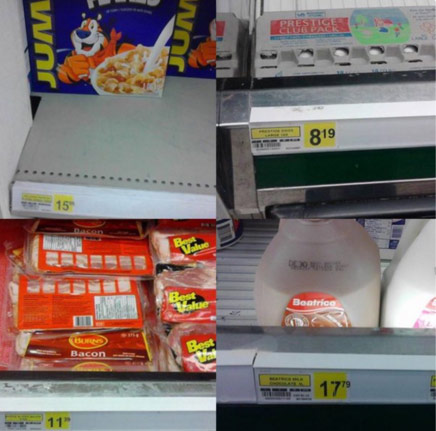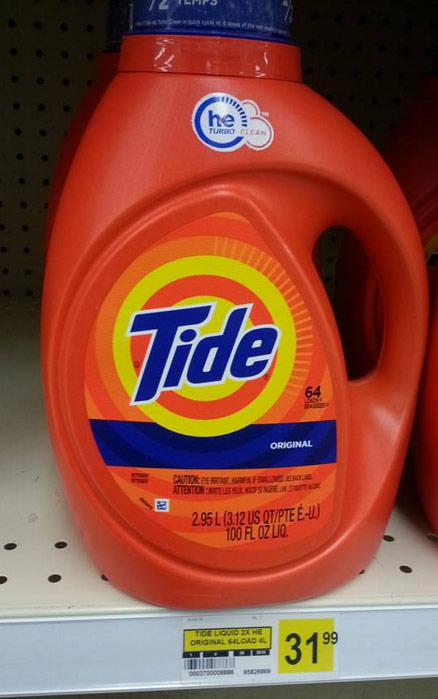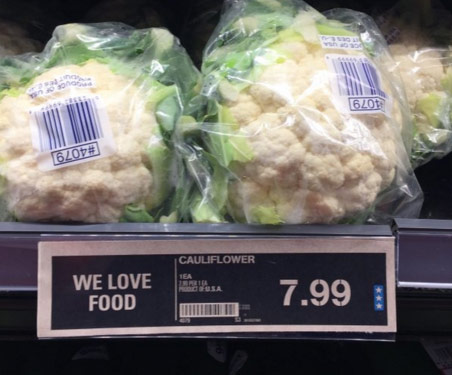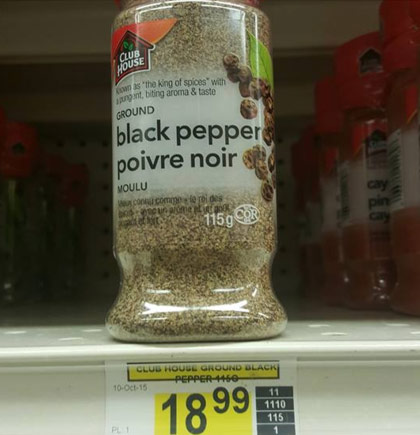REAL TIME CURRENCY COLLAPSE IN CANADA – THIS IS WHAT IT’S GOING TO LOOK LIKE IN THE USA
Canadians Are Panicking Over Food Costs After Currency Collapse
It’s no secret that America has a serious inflation problem. Though the Federal Reserve insists that our inflation rate is only at around .5%, we’ve all seen the price of food, rent, healthcare, and energy skyrocket over the past 10-20 years. However, this has been a gradual shift. Canada on the other hand, has just seen the price of every day goods rise precipitously over a very short period of time.
The crash in oil prices has crippled their economic growth, and led to the decline of the Canadian dollar, as well as a predictable increase in the cost of imports like food. For those of us living in the US, this provides a really good example of what life may be like should the dollar take a plunge in the near future. Here’s what our northern neighbors have been dealing with:
It is often said that a free-floating currency acts as a shock absorber.
But when Canadians go shopping for groceries these days, they’re getting nothing but the shock—sticker shock, that is.
On Tuesday, the Canadian dollar, commonly known as the loonie, broke below 70 U.S. cents for the first time since May 1, 2003.
For America’s northern neighbor, which imports about 80 percent of the fresh fruits and vegetables its citizens consume, this entails a sharp rise in prices for these goods. With lower-income households tending to spend a larger portion of income on food, this side effect of a soft currency brings them the most acute stress.
James Price, director of Capital Markets Products at Richardson GMP, recently joked during an interview on BloombergTV Canada that “we’re going to be paying a buck a banana pretty soon.”
These three old lessons will ensure your children will be well fed when others are rummaging through garbage bins. Click here to learn all about the 3 skills that will help you thrive in any crises situation.
Canadians took to twitter this week to share their collective horror over the rising cost of food. Cucumbers are $3 each. A head of cauliflower is $8. A large container of pepper cost $19 and some Canadians are paying $16 for a single bell pepper. A container of laundry detergent is $32.




This gives us a pretty good idea what would happen in the US, even if there was a minor shock to the value of the dollar. Despite the rising cost of goods and services, our currency has been doing really well on the global stage for the past two years. I shudder to think of what will happen when our economy runs into another recession, which we are way overdue for. When it does hit, the cost of our imports will rise the most, much like they have in Canada.
So what are our main imports? Fortunately, most of our food is homegrown, but there are quite a few American food staples that are also raised abroad, such as bananas, coffee, nuts, and seafood. And even though we’re one of the world’s largest meat producers, we still import a lot of pork and beef from Canada, New Zealand, and Australia. However, that doesn’t mean homegrown food wouldn’t become more expensive as well.
Even though we’ve become one of the world’s leading oil and natural gas producers in recent years, we still import a significant amount of oil from abroad. Since our agricultural industry is heavily reliant on oil, we could expect the price of all our foods, both domestic and imported, to rise.
If you want to understand how our economy would hurt from inflation or a dollar dump, take a look a this list of America’s biggest imports. We ship in a ton of electronics, which are worth about $315 billion per year. For a high-tech society like ours, this would be crippling.
The other items that stand out in that list are healthcare related. When put together, medical equipment and pharmaceuticals amount to 6.3% of our imports. Our medical system is already the most expensive in the world, so a plunge in the dollar’s value would make that situation significantly worse.
All told, a dollar dump would be really bad. That may sound obvious, but when it happens you can expect our government and media to tell us the same thing the leaders in Canada are trying to tell their citizens. Here’s how Steven Poloz, the head of Canada’s central bank, is trying to spin this situation.
Nonetheless, Mr. Poloz insisted that the Canadian dollar, which has plunged to near 70 cents (U.S.), is helping to offset the billions in lost revenue from exports of oil and other commodities. The drop makes Canada’s non-resource exports more competitive in world markets. A lower dollar is generally beneficial to exporters because they pay for their inputs, such as labour, in Canadian dollars, while their sales are generated in the higher U.S. dollar.
This is how all central bankers talk. They could find a silver lining in any situation, even if there was blood in the streets. They’ll say the same thing in the US when the next recession hits and the dollar slips. But it won’t change the fact that everything we need for our survival will be more expensive, and the average person will be making less (or no) money.
I will unearth a long-forgotten secret that helped our ancestors survive famines, wars, economic crises, diseases, droughts, and anything else life threw at them… a secret that will help you do the same for your loved ones when America crumbles into the ground.Watch VIDEO
_____________________________________________________________________
OTHER USEFUL RESOURCES!
Blackout USA (EMP survival and preparedness guide)
Bullet Proof Home (A Prepper’s Guide in Safeguarding a Home )
Backyard Innovator (All Year Round Source Of Fresh Meat,Vegetables And Clean Drinking Water)
Conquering the coming collapse (Financial advice and preparedness )
Liberty Generator (Easy DIY to build your own off-grid free energy device)
Backyard Liberty (Easy and cheap DIY Aquaponic system to grow your organic and living food bank)
Family Self Defense (Best Self Defense Strategies For You And Your Family)
Sold Out After Crisis (Best 37 Items To Hoard For A Long Term Crisis)
US Water Revolution (Generate Your Clean Water Anywhere)
Alive After The Fall (Key Survival Situation Procedures and Knowledge )
Mega Drought USA:(Discover The Amazing Device That Turns Air Into Water)
Survive The End Days (Biggest Cover Up Of Our President)
Survival MD (Best Post SHTF Medical Survival Guide Ever)
This article was originally published by Joshua Krause at Tess Pennington’s ReadyNutrition.com.
Joshua Krause was born and raised in the Bay Area. He is a writer and researcher focused on principles of self-sufficiency and liberty at Ready Nutrition. You can follow Joshua’s work at our Facebook page.



